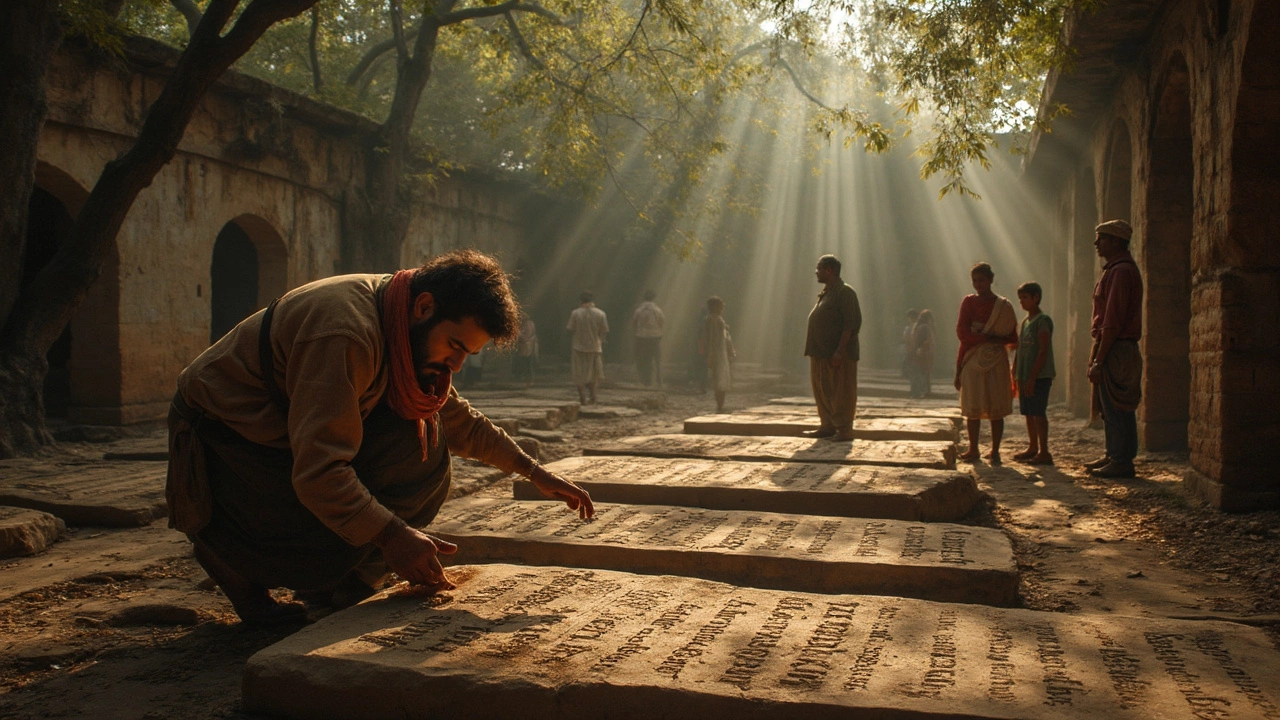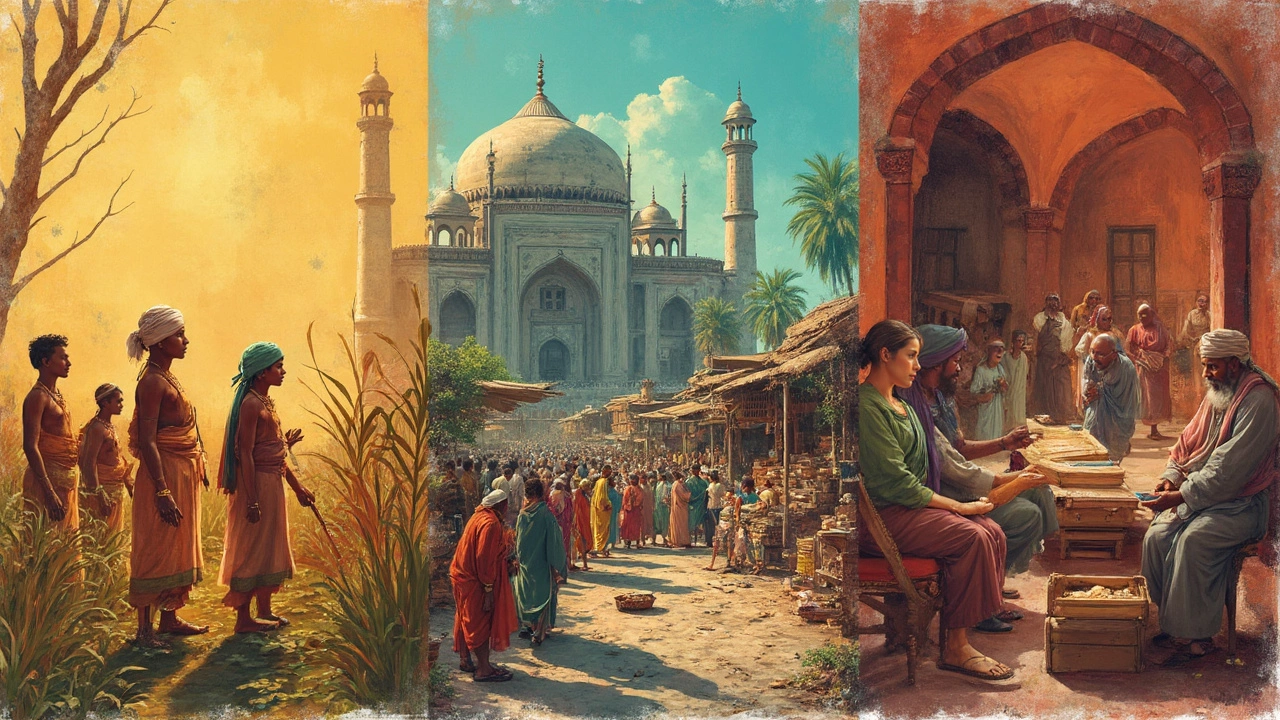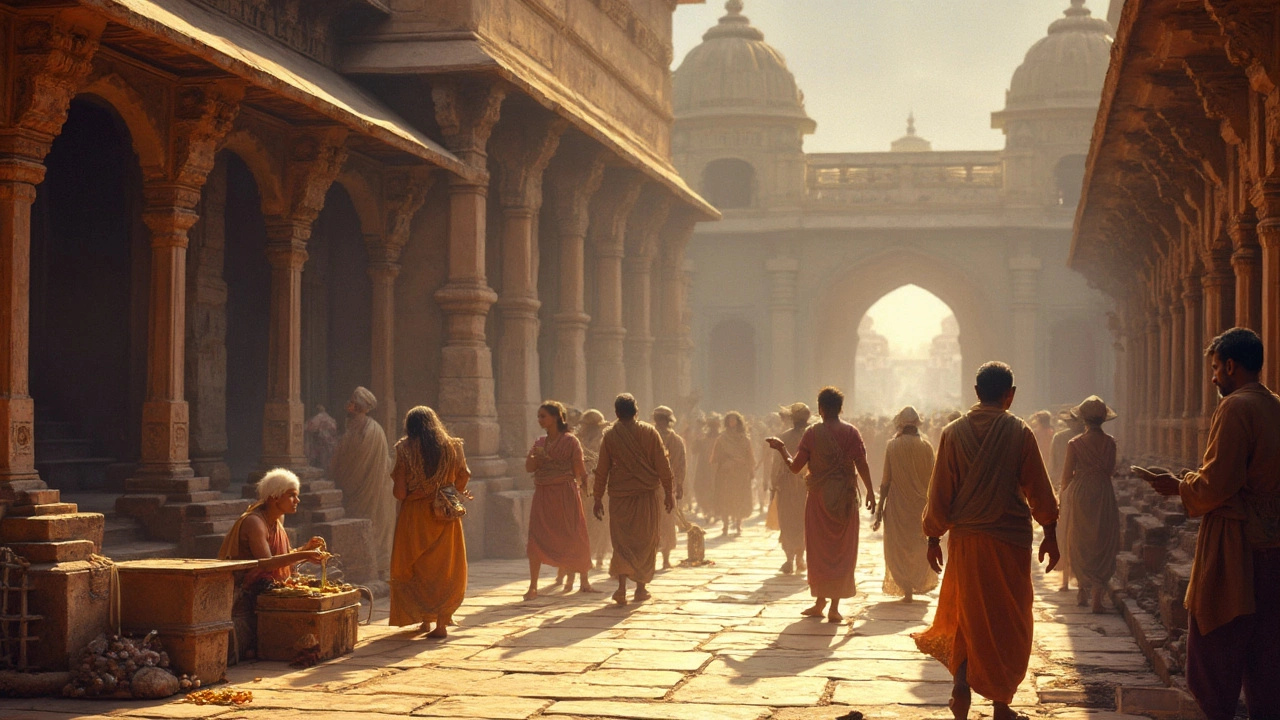Ask anyone about olden times and you’ll usually hear, “People didn’t live long back then, did they?” But what was the real story for folks living around the Taj Mahal, the temples of Khajuraho, or the forts of Rajasthan? We always focus on the buildings, but we rarely think about the lifespans of the people who built, guarded, or prayed inside them.
Old records and handwritten ledgers tucked into temple shelves tell us a lot more than you’d think. Ancient Indian texts, crumbling tombstones, and even tourists' notes from hundreds of years ago drop hints about how long people actually lived. The numbers aren’t just random; they change depending on the region, the era, and how much a person’s work or home put them in harm’s way. Some folks living near these spots had short, rough lives, while others easily reached old age, especially if they were high up in society. Want to know what these monuments and sites quietly say about lifespan? Let’s dig in and see what history left behind.
- Was Lifespan Always Short in Ancient India?
- Digging Deeper: What Heritage Sites Reveal
- Daily Life and Health in the Shadow of Monuments
- What Actually Changed Lifespan Over Time?
- Tips for Finding Lifespan Clues on Your Next Visit
Was Lifespan Always Short in Ancient India?
People imagine ancient India as a place where most didn’t make it past 30. That’s not the full story. The typical lifespan in India depended on a bunch of things—where you lived, what you did, and even when you were born. Looking at the big picture, average life expectancy in ancient times was lower than today, but averages can be misleading. High infant deaths pulled the numbers down fast, yet those who survived childhood often lived much longer than expected.
Take, for example, the Mauryan times around 300 BCE. Historical evidence, like the writings of Greek ambassador Megasthenes, hints that people who made it to adulthood often lasted well into their 50s or 60s. There’s even mention in the Arthashastra—ancient India’s famous treatise on everything from politics to health—about people in government service retiring in their 70s.
Here are some rough numbers that pop up in research and ancient records:
| Era | Estimated Average Lifespan | Notes |
|---|---|---|
| Indus Valley (c. 2500 BCE) | ~35-40 years | High infant mortality, but elders existed |
| Mauryan Empire (c. 300 BCE) | ~40-45 years | More records of elders in power |
| Mughal Period (c. 1500s CE) | ~35-40 years | Survivors often lived into 60s |
| British Colonial Era | ~25-30 years | Poor due to disease and famines |
If you managed to survive childhood diseases, your odds of hitting old age were better, especially if you stayed clear of wars and famines. Most written records from temples and palaces admired people who reached 70, 80, or even beyond. Just walk through old cemeteries near heritage sites in Goa or look at memorials near temple towns in Tamil Nadu—you’ll spot folks living long lives there too.
So, was life always short? Not if you skip the kids lost to illness and consider just the adults. Living into your senior years wasn’t rare at all, especially for those with access to decent food, a safe home, and a bit of luck with health.
Digging Deeper: What Heritage Sites Reveal
Walk through a place like Fatehpur Sikri, and you’ll notice more than just old bricks. Some of the tombs have carved dates—actual proof that people worried about remembering how long their loved ones lived. At Humayun’s Tomb or even inside the Sun Temple at Konark, a close look at inscriptions sometimes gives the birth and death years of kings, queens, or other prominent people. This stuff comes straight out of primary sources, not just guesswork.
If you look at these dates, you notice a pattern. Rulers and priests, who had access to better food and living conditions, often reached their 40s, 50s, or even older. That’s longer than most ordinary workers, whose lives were cut short by disease, accidents, or wars. In fact, experts digging at sites like Lothal in Gujarat found skeletons showing even children were at risk, which brought down the average age. The lifespan in India was never a simple number—it depended on class, location, and even which monument you lived near.
Here’s something cool—not all clues come from tombs. Ancient stepwells, like Rani ki Vav, have carvings hinting at rituals for long life. Scripts recorded next to the figures talk about offerings for health, showing that communities cared a lot about living longer. Sometimes, inside forts and palaces, you’ll spot paintings or small wall notes made by caretakers marking big events or deaths, which helps historians piece together a timeline.
Want a pro tip? If you’re walking around a heritage site, watch for little details on plaques, pillars, or old visitor records (some sites show these in their onsite museums). You’re basically looking at early versions of people’s diaries—they’re full of hints about daily life, health, and death back when the monuments were alive with activity.

Daily Life and Health in the Shadow of Monuments
Walking through spots like Hampi or Fatehpur Sikri, it’s tempting to imagine everyone living in grand palaces. The real story was messy. Everyday life around these heritage sites India was a grind for most. Endless laborers sweated through hot afternoons hauling stones. Builders, cleaners, and vendors slept in crowded quarters, often right on dusty temple steps or near fort walls. People built markets, washed clothes, cooked, and raised kids in the shadows of these monuments.
Nutrition played a huge part in how long people lived. Royal kitchens served up rice, dal, and plenty of ghee, but the ordinary folks usually ate simple meals—flatbreads, lentils, and whatever local veggies they could find. Not a lot of meat unless you were in a rich household. Clean water wasn’t always a given either, and bad water led to lots of disease back then, especially before British-era water tanks and wells popped up around popular sites.
Sickness hit hard. Cholera, malaria, and smallpox wiped out big chunks of the population around the Ganges, Delhi, and Agra at different points in time. Healers and ancient doctors (vaidyas and hakims) did their best using Ayurveda and Unani medicines, but without vaccines or antibiotics, outbreaks meant a lot of kids didn’t get past their fifth birthday. If you made it through the first few years, though, you had a good shot at living into your 40s or even 50s, sometimes longer if you avoided war, famine, and infection.
| Period | Common Jobs | Main Health Risks | Avg. Lifespan |
|---|---|---|---|
| 10th-12th C (Khajuraho) | Stone carvers, temple priests | Injuries, infections | 28-35 years |
| 16th C (Agra/Fatehpur Sikri) | Laborers, traders, cooks | Malaria, cholera | 30-40 years |
| 18th-19th C (British Raj) | Caretakers, artisans, guards | Waterborne diseases | 35-45 years |
Want a tip for glimpsing daily life at a heritage site? Check out the carvings, old kitchens, and stepwells—many still have worn marks and graffiti from workers, not kings. Local guides love to share stories about festivals, schoolyards, and markets that popped up near palaces and temples. The monuments weren’t just showpieces; they were the heart of regular life, packed with real people and real struggles.
What Actually Changed Lifespan Over Time?
Lifespans in India used to swing a lot, depending on where you lived, what you did, and how much money you had. If you visit sites like Fatehpur Sikri, there's proof some people didn’t even make it past their 30s, while a lucky few—usually royals or clergy—could live into their 60s or more. But what actually drove these huge differences?
First off, disease was the biggest game-changer. Before vaccines and modern medicine, plagues and cholera outbreaks could wipe out whole towns. Childbirth was risky for women. Clean water was rare, especially in big, bustling cities like Varanasi. Check out this chunk from 'A History of India' by Romila Thapar:
“The regular outbreaks of epidemic disease and the lack of reliable sanitation kept the average life expectancy for most people startlingly low up to the 19th century.”
While it’s easy to blame just sickness, wars around sites like Golconda Fort or Hampi also led to lower lifespans. Armies lived short lives, and their families suffered when invaders passed through. Social class mattered too—merchants and priests at major temples generally had better food and sheltered lives, compared to laborers or farmers who worked on heritage site lands.
By the 1800s, things started shifting with cleaner water, a few hospitals, and more global trade. The British colonial records from Delhi and Agra note average lifespans inching up from about 25-30 years to closer to 40 years by the late 19th century, mostly in urban zones. Here’s a simple data table to put things in perspective:
| Era / Year | Average Lifespan (Years) | Main Factors |
|---|---|---|
| 1100-1500 CE | 25-32 | Disease, wars, poor hygiene |
| 1500-1800 CE | 28-35 | Epidemics, famines, class gap |
| 1800-1900 CE | 33-40 | Better medicine, urban sanitation |
One thing that stands out at every famous site: as soon as people got access to more stable food, less polluted water, or even basic herbal medicine, lifespan jumped. These factors changed the story for most people, not just the kings and priests whose names you see carved in the walls.
That’s why lifespan in India can’t be pegged to a single number. It’s linked to wars, water, jobs, and who happened to catch a break from disease. Even today, when you tour a heritage site, look for old wells or community kitchens—they’re tiny clues to what actually helped folks live longer back then.

Tips for Finding Lifespan Clues on Your Next Visit
Next time you’re exploring a fort or temple, don’t just snap selfies or stare at carvings. There are real-life stories hidden around you—if you know where to look. Here’s how you can spot clues about how long people actually lived at these places.
- Check out tombstones and memorial plaques. Not every spot will have these, but some places like the Qutb Shahi Tombs in Hyderabad or the memorials at Gwalior Fort have stones that list birth and death years. If a nameplate says “born 1524, died 1590,” you’ve got hard evidence right there. Sometimes you’ll see kids’ graves or markers for local rulers who lived a surprisingly long time.
- Look up inscriptions inside temples or along corridors. South Indian temples often include records of donors—sometimes you’ll spot bits like “Devadasi, aged 70, donor of the well.” That’s a direct clue someone lived into old age.
- Scan for old paintings and wall art. At Hampi and Ajanta, you’ll see groups or families. Sometimes, older folks are painted with white beards or walking sticks, hinting they were respected and probably made it past middle age.
- Ask your guide about famous residents. Some sites keep a list of notable people—like priests, builders, or royals—and their life stories. Don’t be shy; even a guard sometimes knows a nugget of info not in the brochure.
- Check the site’s own mini-museums. Many have a cabinet full of written records, marriage registers, or old census entries. Slow down and read the notes—they can give exact ages or mention a donor who lived past 80, which was rare but not impossible.
Want some numbers? Here’s a quick peek at actual ages from famous Indian heritage sites:
| Site | Oldest Recorded Age (in years) | Common Life Expectancy (Era) |
|---|---|---|
| Qutb Shahi Tombs | 78 | 35-45 (16th-17th cent.) |
| Brihadeeswarar Temple | 75 | 40-50 (11th cent.) |
| Amber Fort | 72 | 35-45 (16th-18th cent.) |
If you’re serious about uncovering what living at a heritage site was really like, keep your eyes peeled for even small details—a birth date chiselled in stone or a faded mural showing grandparents. That’s the real history you’ll remember way after the tour buses leave.
